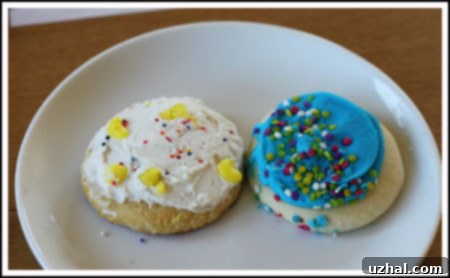The Ultimate Homemade Lofthouse Cookie Clone: Soft, Cakey, and Perfectly Frosted
There’s a certain magic to a Lofthouse cookie. That incredibly soft, almost cake-like texture, the rich and sweet frosting, and the vibrant sprinkles – it’s an iconic treat that evokes a sense of nostalgia for many. For a while, these delightful sugar cookies had slipped from my mind, but a recent conversation brought them back into focus. Intrigued, and with a completely refreshed memory of their unique taste, I decided it was time to revisit them. My mission was clear: understand what makes them so universally loved and, if possible, recreate that magic right in my own kitchen. I grabbed a box of the classic blue-frosted variety, and my furry companion, Fuzz, enthusiastically approved.
One of the most persistent rumors about Lofthouse cookies is their irresistible quality – once you start, it’s incredibly difficult to stop. Fuzz and I took this warning seriously, holding off our sampling until after a satisfying, protein-packed lunch. Fuzz, ever the disciplined one, noted the official serving size of “one cookie” and declared she would stick to it. While she managed to exercise admirable restraint, my experience was a little different. These cookies were even better than I remembered, instantly transporting me back to childhood. They were pristine white, as if made from freshly fallen snow, incredibly soft, and nearly as crumbly as traditional polvorones. Each bite was bursting with a complex flavor profile, undoubtedly thanks to a masterful blend of extracts that gave them their distinctive character. This re-introduction solidified my resolve: I had to crack the code to these delightful treats.
The Quest for the Perfect Lofthouse Cookie Clone
My journey to create the ultimate Lofthouse cookie clone began with a sense of excitement and a deep dive into existing recipes. The goal was not just to make a good sugar cookie, but to replicate that specific, beloved Lofthouse experience: the unique texture, the delicate crumb, and the unforgettable flavor. It was a culinary challenge I was eager to embrace.
My first attempt involved a recipe from Food.com, aptly named “Lofthouse Cookie Clones.” I had tried this particular recipe in the past, and it yielded a genuinely delicious cookie. However, upon a side-by-side comparison with the authentic Lofthouse, I immediately noticed some key differences. While tasty, these cookies were notably puffier, had a more pronounced cakey texture, and possessed a distinct yellowish hue, unlike the strikingly white original. They were more akin to mini iced yellow cakes than the soft, almost airy Lofthouse cookies I was aiming for. Despite not being a perfect match, they were undeniably good, especially after a night spent frosted in a sealed container, which allowed their flavors to meld beautifully. This initial experiment, though not a complete success, provided valuable insights into what worked and, more importantly, what needed adjustment in my pursuit of the perfect clone.
Undeterred, I ventured further into the vast world of online recipes, specifically targeting forums where passionate home bakers were undertaking their own cloning endeavors. Among these, one forum user claimed to possess the original ingredient list, sparking my interest. I meticulously followed her recipe, along with a few others shared within the same thread. A conscious decision was made to avoid any recipes that included cake mix, as I believed true replication required a more fundamental approach to ingredients. Unfortunately, these attempts fell short of expectations. While they did produce a denser cookie than my first cakey and yellow clone, they severely lacked the vibrant flavor that defines the Lofthouse original. The texture was also off; instead of that signature melt-in-your-mouth softness, these were somewhat heavy and less appealing. Each failed batch, however, brought me closer to understanding the subtle nuances required to achieve the desired outcome.
With external recipes proving unsatisfactory, I decided it was time to trust my own culinary instincts and embark on a series of independent experiments. My initial focus was on dairy, trying several recipes that incorporated heavy cream, and then a few more with sour cream, hoping to achieve that characteristic moistness and slight tang. Given that rice flour was listed as an ingredient on the label of the original Lofthouse cookies, I also experimented with incorporating it into a few of my self-developed recipes, theorizing it might contribute to the distinct crumb structure. Despite these varied efforts and the meticulous adjustments I made, none of my homemade cookies truly captured the essence of Lofthouse. In fact, they didn’t even measure up to the first, admittedly cakey, recipe I had tried. It was a humbling period of trial and error, but it taught me invaluable lessons about ingredient ratios and the delicate balance required to mimic such a unique commercial product.
Cracking the Code: The Lofthouse Clone Icing
After numerous attempts to perfect the cookie base, I realized that the magic of a Lofthouse cookie isn’t just in the cookie itself, but significantly in its iconic frosting. The Lofthouse frosting is distinctive: thick, intensely sweet, surprisingly light, and with that subtle “crusted” exterior that holds its shape beautifully while remaining soft underneath. Replicating this unique texture and flavor became another critical component of my cloning quest.
My journey through the world of frostings was as extensive as my cookie experiments. I started with an Italian Meringue, which, while elegant and smooth, simply wasn’t sweet enough for the Lofthouse profile. Next, I tried a marshmallow buttercream, hoping its airy texture would be a match, but it too lacked the specific richness and body. A basic buttercream recipe, found on the side of a powdered sugar box, proved delicious in its own right – sweet and creamy – but it didn’t quite achieve that signature Lofthouse finish that subtly sets after drying. Each variation, though enjoyable, reaffirmed how crucial the right frosting was to the overall Lofthouse experience.
The breakthrough came from an unexpected source: a recipe I stumbled upon in a scrapbookers’ forum. Yes, a scrapbookers’ forum! It seemed that many creative individuals, beyond just baking, appreciated the aesthetic and textural qualities of a well-made frosting. This particular recipe, which called for egg whites, shortening, butter, powdered sugar, and a blend of flavorings, immediately caught my attention. It was unconventional, but I was desperate for a solution. To my absolute delight, this recipe yielded the most delicious, best-textured frosting of the entire bunch. The flavor was spot on, a perfect balance of sweetness and subtle notes, but what truly amazed me was how it crusted over, just like the original Lofthouse frosting, while remaining wonderfully soft and creamy underneath. It was the missing piece of the puzzle, bringing the entire clone concept together.
The key ingredient, I discovered, was the shortening. For the ultimate smooth texture and enhanced flavor, I highly recommend using high-ratio shortening. This specialized shortening contains emulsifiers that allow it to hold more liquid and sugar, resulting in an exceptionally smooth and stable frosting. While you can find large quantities of it on Amazon, smaller amounts are also available from various baking supply sources. Integrating this particular frosting recipe with my refined cookie base finally allowed me to achieve what I had set out to do: a true Lofthouse cookie clone.
The combination of a tender, flavorful cookie and this remarkable, perfectly crusted frosting creates an experience that truly mimics the original. After all the experimentation, the testing, and the occasional disappointments, the result was a cookie that brought back all those fond memories, now handcrafted with love. It’s a testament to patience and persistence in the kitchen, proving that with enough dedication, even the most iconic commercial treats can be successfully recreated at home.
- Soft and Cakey Cookies
- Lofthouse Cookie Madness
- John’s Amish Sugar Cookies
- Eating Well Brownies
- Zingerman’s Magic Brownies Clone
Recipe

Lofthouse Cookie Clone
Anna
Pin Recipe
Ingredients
- 2 sticks salted butter, room temperature (230 grams)
- 2 cups granulated sugar (400 grams)
- 3 large eggs
- 1 teaspoon vanilla extract
- 1 teaspoon baking soda
- 1 teaspoon baking powder
- 1 ½ cups sour cream room temperature
- 5-6 cups flour until desired consistency for rolling — I used 6
Frosting
- 2 large egg whites pasteurized
- 4 oz salted butter softened
- ½ cup shortening, preferably high ratio softened
- 4 ½ cups of powdered sugar.
- ¾ teaspoon vanilla
- ¼ teaspoon almond extract
Instructions
-
Preheat oven to 400 degrees F (200 degrees C). Prepare your baking sheets by lining them with parchment paper for easy removal and cleanup.
-
In a large mixing bowl, preferably using a stand mixer with the paddle attachment, beat the softened salted butter until it’s light and creamy. Gradually add the granulated sugar and continue beating on medium-high speed until the mixture is truly creamy and visibly lighter in color, about 2-3 minutes. This step is crucial for incorporating air and achieving a tender cookie.
-
Add the large eggs one by one, ensuring each egg is fully incorporated into the butter-sugar mixture before adding the next. Scrape down the sides of the bowl as needed. Once the eggs are in, beat in the vanilla extract, baking soda, and baking powder. Mix until just combined.
-
Gently stir in the room temperature sour cream until it’s evenly distributed throughout the batter. The sour cream contributes significantly to the cookies’ characteristic moistness and slight tang.
-
Gradually add the flour, starting with 5 cups, and mix on low speed until just incorporated. Be careful not to overmix, as this can develop the gluten too much, leading to tough cookies. If the dough is too sticky to roll, slowly add the remaining flour (up to 6 cups) until you achieve a soft, pliable dough that can be easily handled. I found 6 cups to be the ideal amount for rolling.
-
Divide the dough in half. Wrap one half tightly in plastic wrap and refrigerate it while you work with the first half. On a lightly floured surface (or between two sheets of parchment paper), roll the remaining dough to about ¼ inch thick. Using a small circular cookie cutter (about 2-2.5 inches), cut out the cookies. Carefully arrange them on your parchment-lined cookie sheets, leaving a little space between each. Bake for 12-15 minutes, or until the edges are just lightly golden. The cookies should remain pale in the center for that true Lofthouse look and softness. Bake one sheet at a time for even cooking. Repeat this process with the refrigerated dough until all cookies are baked. Allow them to cool completely on a wire rack before frosting.
-
For the Frosting: In the bowl of your standing mixer, preferably with the whisk attachment (or paddle for a denser frosting), add the pasteurized egg whites and begin beating on medium speed. Once they start to become foamy, gradually add the softened salted butter and softened shortening. Increase the speed to high and beat until the mixture is light and fluffy. Slowly add half of the powdered sugar, mixing until well combined and creamy. Then, add the remaining powdered sugar, vanilla extract, and almond extract. Continue beating on high speed for several minutes until the frosting is incredibly light, airy, and creamy, with a noticeable increase in volume. Spread a generous amount of frosting onto each cooled cookie. Decorate with sprinkles if desired for that classic Lofthouse touch. The frosting will set slightly, forming a delicate crust, just like the original!
Notes
